International Steel Prices

US HR prices remain sharply higher than EU HR on 50% S232
Written by David Schollaert
July 24, 2025
Hot-rolled (HR) coil prices in the US edged lower again this week, but have remained in a tight band for roughly four months. Stateside prices continue to trail imports from Europe, supported by Section 232 steel tariffs that were doubled in early June.
Recall the tariff hike to 50% on June 3 reversed earlier gains from March. At that time, reimposed undiluted Section 232 rules had briefly narrowed the price gap between domestic HR and imports on a landed basis.
Prior to March, allies such as Japan and the EU had not been subject to the 25% S232 tariff. Instead, they had tariff-rate quotas. The price gap immediately widened again after S232 was doubled to 50% (see Figure 1).
By the numbers
SMU’s average domestic HR coil price declined $10 this week to $845 per short ton (st). That’s level with where prices were when tariffs were doubled.
Even so, US hot band is still 6.7% cheaper than imports, up from 4.9% last week, and a clear shift from seven weeks ago when it was roughly 3% more expensive.
If Asian prices weren’t at such a discount to US prices, stateside product would be roughly 15% cheaper than imports. HR imports from Germany and Italy, on a landed basis, are much more expensive than US hot band.
Today, in dollar-per-ton terms, US product is on average $57/st less than imports. The gap was $42/st less last week and is a swing of more than $80/st before the tariff hike.
The charts below compare HR prices in the US, Germany, Italy, and Asia. The left side highlights prices over the last two years. The right side zooms in to show more recent trends.
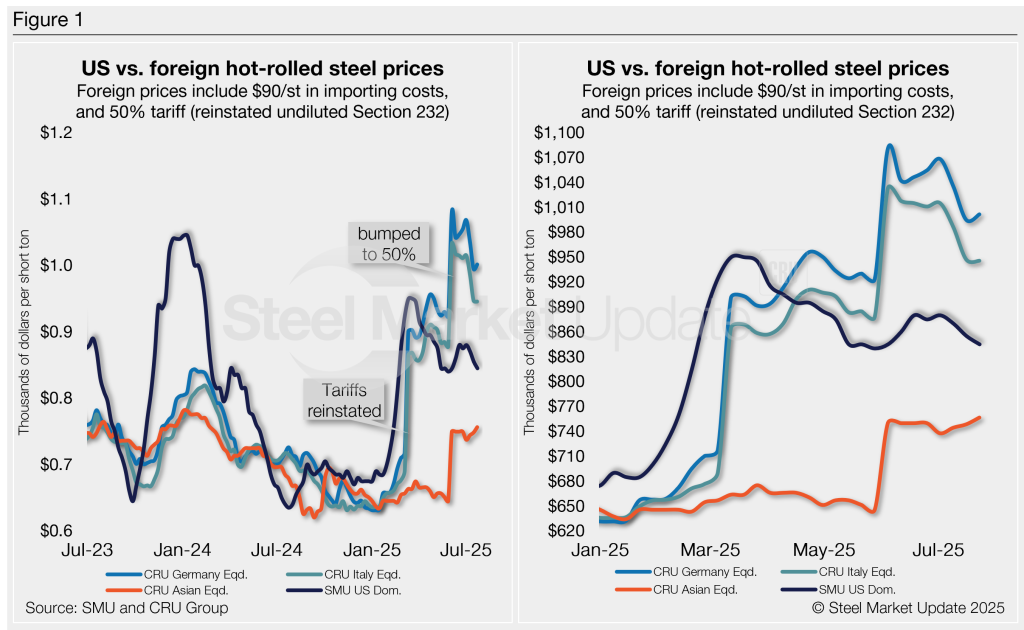
Methodology
SMU calculates the theoretical spread between domestic (FOB mill) and foreign (delivered to US ports) HR coil prices. We do this by comparing our weekly US HR assessment to CRU’s weekly HR indices for Germany, Italy, and Southeast Asian ports. This calculation is purely theoretical. Actual import costs can vary significantly and affect the true market spread.
To estimate the CIF price at US ports, we add a $90/st charge to all foreign prices to account for freight, handling, and trader margins, along with the 50% blanket tariff. This $90/st figure serves as a general benchmark. Buyers should adjust it based on their specific shipping and handling expenses.
If you import steel and have insights on these costs, we’d love to hear from you. Contact the author at david@steelmarketupdate.com.
Asian HRC (Southeast Asian ports)
As of Wednesday, July 23, the CRU Asian HRC price was $445/st, up $6/st vs. the week prior. Adding a 50% tariff and $90/st in estimated import costs, the delivered price of Asian hot band to the US is ~$757/st. As noted above, the latest SMU US HR price is $845/st on average.
The result: Prices for US-produced HR are theoretically $88/st higher than steel imported from Asia, down $18/st week over week (w/w). Despite the cut tariff margin, the premium remains well below recent highs seen in 2023 when stateside tags were ~$300/st more expensive than Asian product.
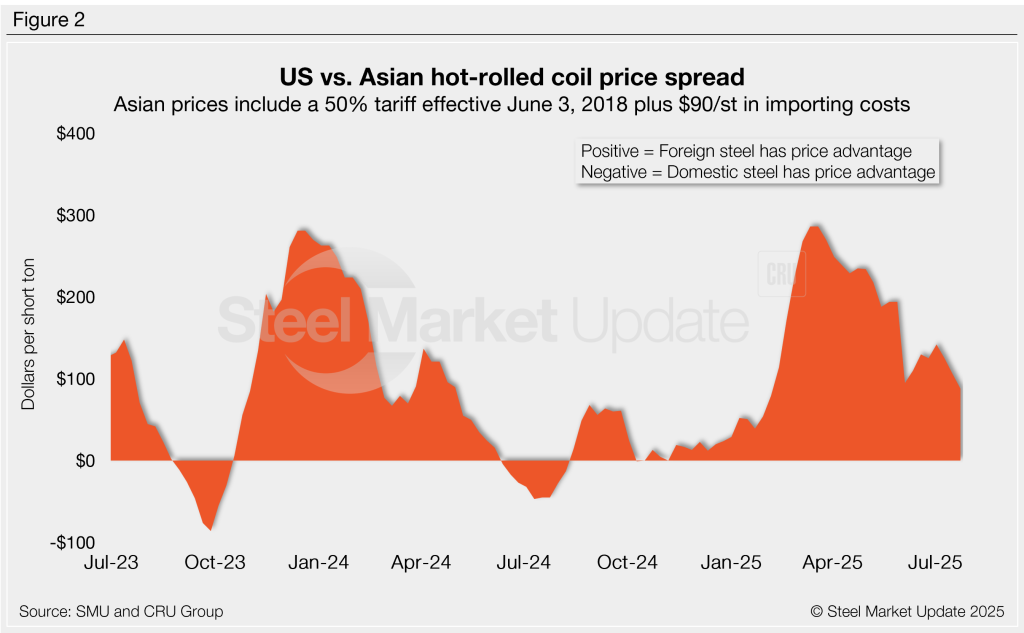
Italian HRC
Italian HR prices slipped by just $1/st this week to $571/st, and have declined about $44/st over the past four weeks, according to CRU. After doubling tariffs to 50% and adding $90/st in estimated import costs, the delivered price of Italian HR is, in theory, $946/st.
That means domestic HR coil is theoretically $101/st cheaper than imports from Italy. That’s $1 lower w/w and represents a $335/st swing from before S232 was reinstated and then doubled. Without the 50% tariff, US prices, in theory, would be $184/st above Italian imports.
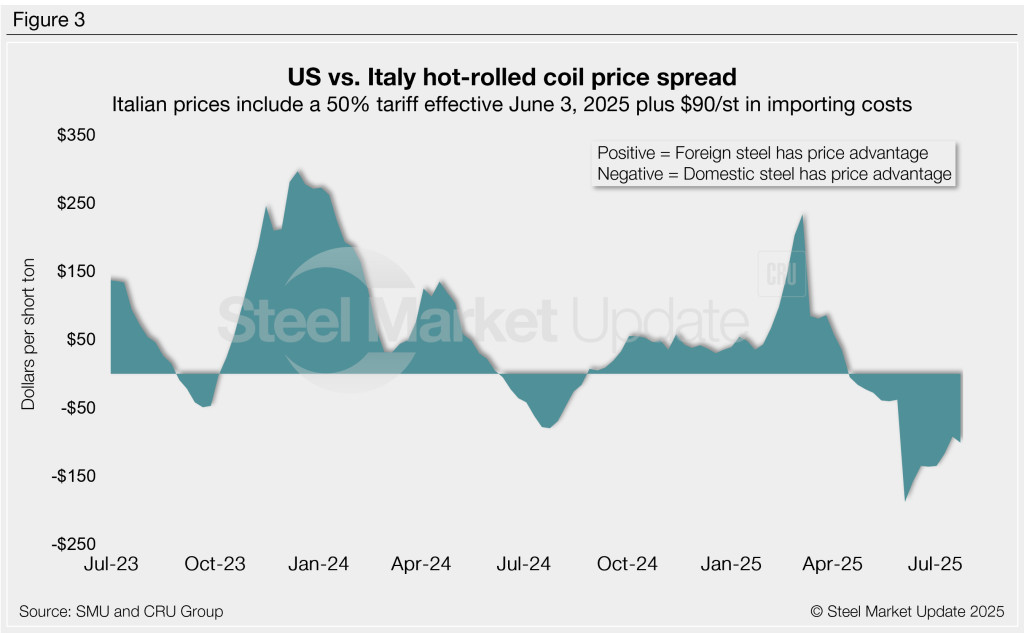
German HRC
CRU’s German HR price was up $5/st to $608/st this week. After adding a 50% tariff and $90/st in import costs, the delivered price of German HR coil is, in theory, $1,002/st.
The result: Domestic HR is theoretically $157/st cheaper than HR imported from Germany, a $17/st cut vs. last week.
US hot band held a $207/st premium over German HR just about three months ago, which had represented the widest margin in 14 months. Without the 50% tariff, US prices would be $147/st above German imports in theory.
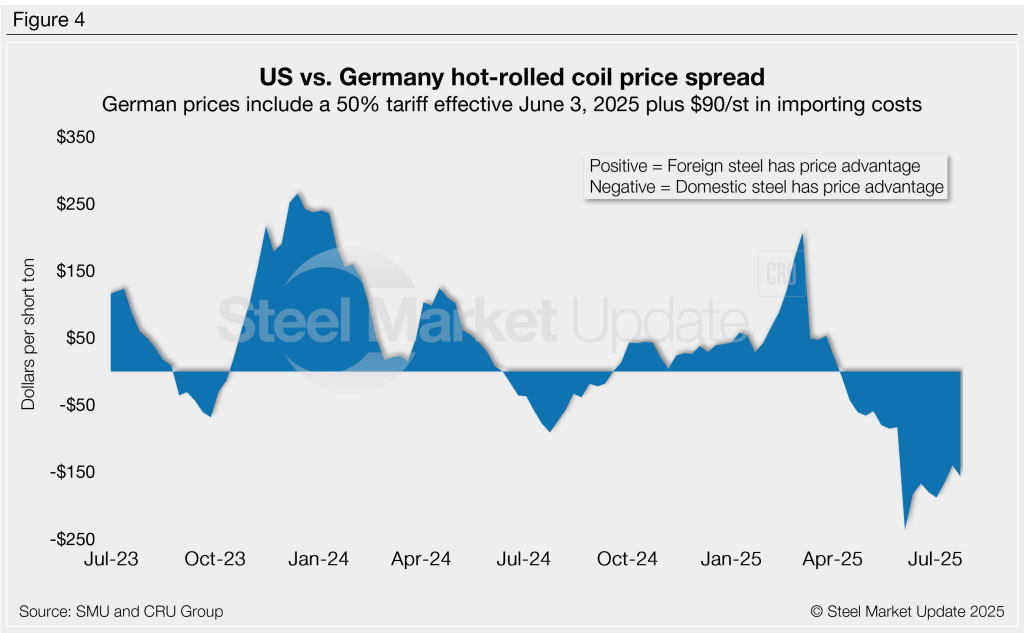
Editor’s note
Freight is important when deciding whether to import foreign steel or buy from a domestic mill. Domestic prices are referenced as FOB the producing mill. Foreign prices are CIF, the port (Houston, NOLA, Savannah, Los Angeles, Camden, etc.). Inland freight, from either a domestic mill or from the port, can dramatically impact the competitiveness of both domestic and foreign steel. It’s also important to factor in lead times. In most markets, domestic steel will deliver more quickly than foreign steel. On March 12, 2025, undiluted Section 232 tariffs were reinstated on steel. All steel imports and many derivative products faced a 25% tariff. Effective June 6, 2025, Section 232 tariffs were increased to 50%. Therefore, the German and Italian price comparisons in this analysis now include a 50% tariff. We do not include any antidumping (AD) or countervailing duties (CVD) in this analysis.

David Schollaert
Read more from David SchollaertLatest in International Steel Prices

US CRC prices dip, widening gap vs. imports
Cold-rolled (CR) coil prices continued to decline in the US this week, while prices in offshore markets ticked higher.
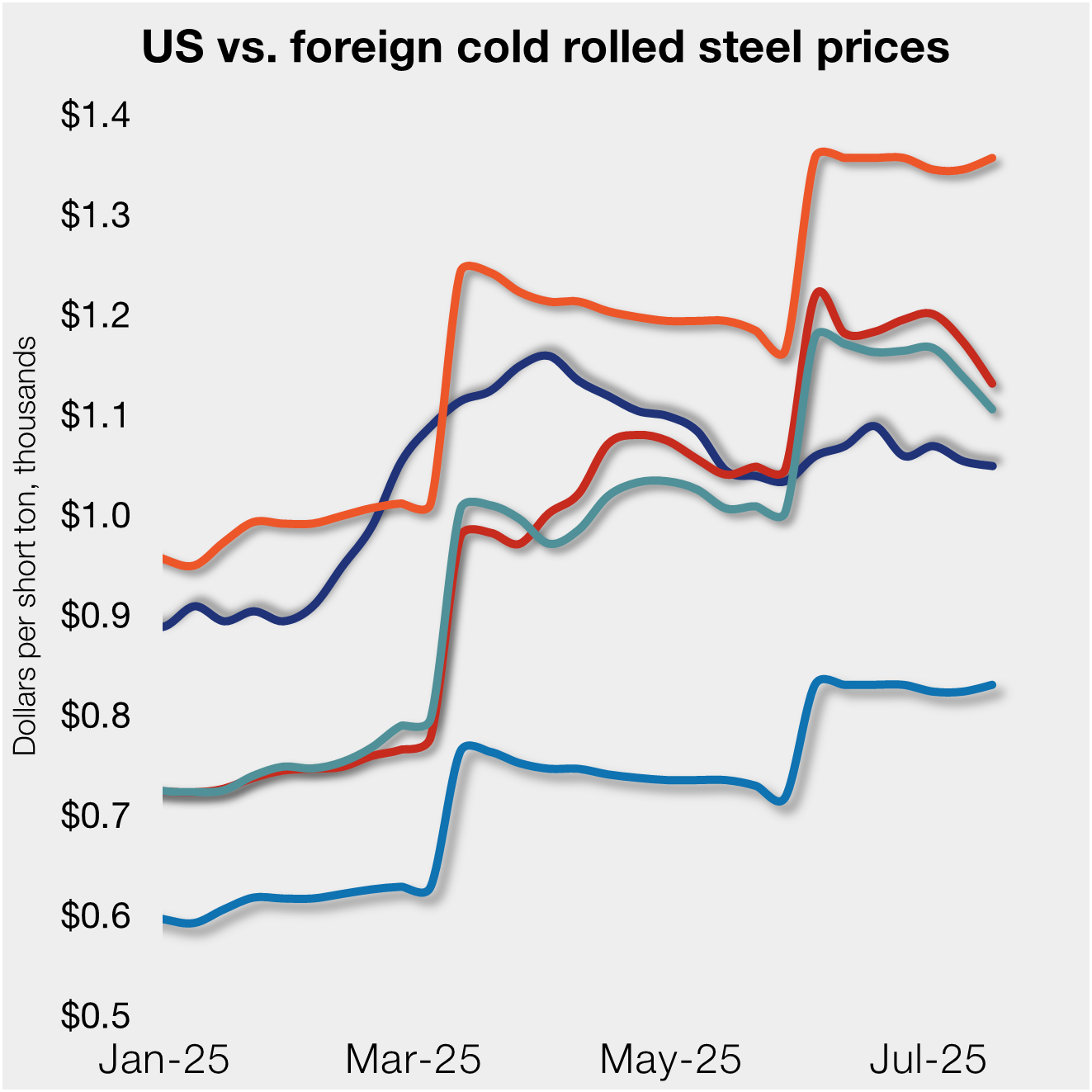
CRC price declines tighten US vs. EU gap
Cold-rolled (CR) coil prices continued to tick lower in the US this week, with a similar trend seen in offshore markets.

CRU Outlook: Near-term regional steel price trends will diverge
Chinese steel export prices are expected to rise and support prices across most of Asia in the coming month. In Europe, buyers are likely to frontload import orders ahead of CBAM imposition, while new trade agreements are likely to emerge in the US. Steel prices in the APAC are expected to rise, except in India […]
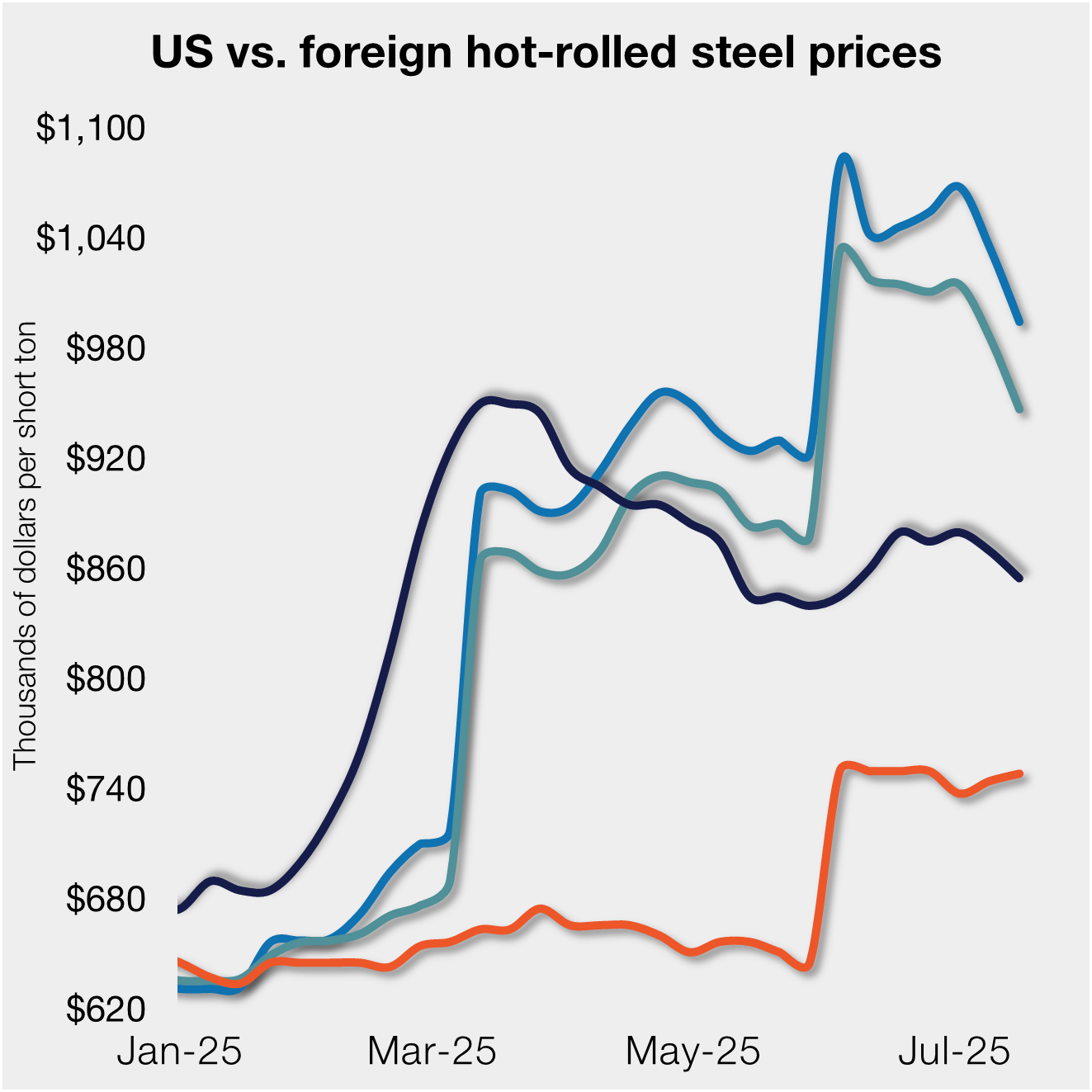
US, EU HR prices decline, doubled S232 tariffs maintain the gap
Stateside prices continue to trail imports from Europe, supported by Section 232 steel tariffs that were doubled in early June.
